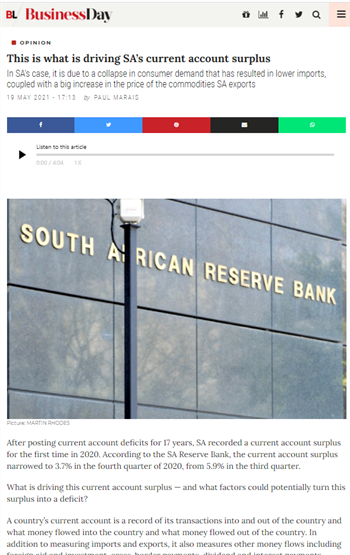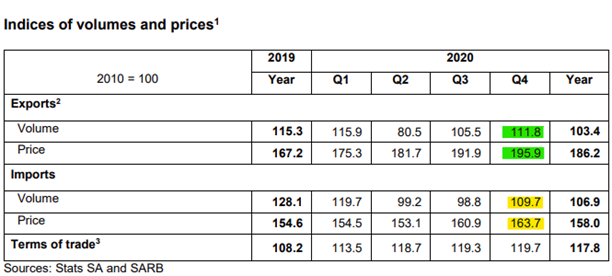How long can South Africa maintain its current account surplus?
In SA’s case, it is due to a collapse in consumer demand that has resulted in lower imports, coupled with a big increase in the price of the commodities SA exports.


After posting current account deficits for 17 years, South Africa recorded a current account surplus for the first time 2020. According to the South African Reserve Bank, the current account surplus narrowed to 3.7% in the fourth quarter of 2020, from 5.9% in the third quarter.
What is driving this current account surplus – and what factors could potentially turn this surplus into a deficit?
A country’s current account is a record of its transactions into and out of the country and what money flowed into the country and what money flowed out of the country. In addition to measuring imports and exports, it also measures other money flows including foreign aid and investment, cross-border payments, dividend and interest payments.
A current account surplus means that more money is flowing into the country than out of the country and is typically considered a positive for inflation, interest rates and currency.
However, in South Africa’s case the current account surplus is due to a collapse in consumer demand which has resulted in lower imports, coupled with a big increase in the price of commodities which we export. In a nutshell, in terms of value we are currently exporting more than we are importing.
In the fourth quarter of 2020, exports hit an all-time high, with both the price and volume of exports outweighing that of imports. In January this year the top four exports were platinum, iron ore, gold and coal briquettes.
While South Africa is also a significant exporter of agricultural products, the price effect is not as significant in agriculture compared to commodities.
The next part of the current account formula is due to net income from abroad and transfers in the form of donations or foreign aid. Although this latter aspect is usually ignored, Covid relief funds from the likes of the International Monetary Fund (IMF) and World Bank could well have played a part in the current account surplus.
There are a number of factors – some less likely than others - which could potentially swing the current account surplus back into a deficit position. The most obvious impact would be a rise in consumer demand which increases imports. In the current environment – and in the short term – this is an unlikely scenario given the depressed state of the economy.
Another potential reason for the current account to fall into a deficit would be a reduction in exports. This scenario too is unlikely given the strong demand for commodities as developed markets recover and China re-focuses on its Belt and Road infrastructure initiative. Commodity prices, in particular the price of metals, have risen considerably in recent months, buoyed by rising demand in expectation of a global economic recovery as vaccines are rolled out and fiscal stimulus initiatives are implemented in developed markets.
Refined petroleum and crude petroleum were amongst the top three imports in January 2021. The current strength of the Rand and less demand for oil as people travel less will have neutralised the increase in oil price. However, should the oil price continue to rise, this could lead to deficits.
Tourism, which traditionally counts as an import, is clearly in deficit right now with many countries restricting travel to South Africa. According to data from Stats SA the overall number of travellers – this includes both arrivals and departures – decreased by 71.6% from 10.2 million in 2019 to 2.8 million in 2020. The overwhelming majority of tourists last year were from SADC or other African countries. Tourism could potentially reflect an even bigger decline this year although it can’t fall below zero.
The surplus effect of net capital transfers in the forms of loans to South Africa have in all likelihood come to an end given that the IMF and World Bank are unlikely to keep lending the country money.
Foreign acquisitions of equities and bonds – which has occurred in fits and starts rather than consistently – is a short-term surplus transfer but as the capital ultimately leaves the country it has a long-term negative effect on the current account surplus.
The consensus amongst most economists appears to be that South Africa will continue to report a current account surplus in the short term given higher commodity prices and a supportive global environment.
 |
This article was published by Business Day on 19 May 2021. |














